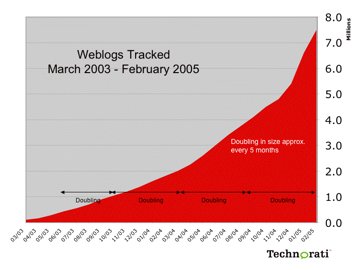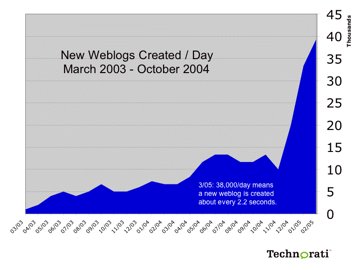It's been 5 months since my first presentation on the State of the Blogosphere at the Web 2.0 conference, which I later posted in parts. A lot has happened, and its time for an update on what's going on in the world of weblogs, and to have a look at the numbers.
I'll be posting this in a number of parts, as there's a lot of information to cover. Today, I'll be focusing on the macro growth of the blogosphere, both in the aggregate number of bloggers out there, as well as the growth of the number of new blogs per day. Here's the chart of the aggregate growth of the blogosphere from March 2003 to February 2005 (compare this chart with the one from October 2004):
Technorati is now tracking over 7.8 million weblogs, and 937 million links. That's just about double the number of weblogs tracked in October 2004. In fact, the blogosphere is doubling in size about once every 5 months. It has already done so at this pace four times, which means that in the last 20 months, the blogosphere has increased in size by over 16 times.
Things don't appear to be letting up either. With the launch of MSN spaces and the continued significant growth of popular blogging and journaling tools like Google's Blogger, SixApart's LiveJournal, AOL Journals, and proliferation of software like WordPress and Movable Type, the number of people out there blogging has jumped in the past few months. The chart below shows the significant jump in the number of new blogs created per day (compare with the chart from October 2004):
We are currently seeing about 30,000 - 40,000 new weblogs being created each day, depending on the day. Compared to the past, this is well over double the rate of change in October, when there were about 15,000 new weblogs created each day. The remarkable growth over the past 3 months can be attributed to the increase in new, mainstream services such as MSN Spaces, and in increases of use of services like Blogger, AOL Journals, and LiveJournal. In addition, services outside the United States have been taking off, including a number of media sites promoting blogging, such as Le Monde in France.
There is a dark underbelly to these numbers, however: Part of the growth of new weblogs created each day is due to an increase in spam blogs - fake blogs that are created by robots in order to foster link farms, attempted search engine optimization, or drive traffic through to advertising or affiliate sites. We have been battling the spam situation in a significant way for about 2 months - prior to January, spam wasn't much of an issue. All of these charts reflect Technorati's databases after spam blogs have been removed, and we feel that we've been able to capture and identify most of the spam out there, but one should note that there is definitely blog spam that we don't catch (tell us if you see spam in the index!). I'd estimate that we currently catch about 90% of spam and remove it from the index, and notify the blog hosting operators. Most of this fake blog spam comes from hosted services or from specific IP addresses. One of the results of the extremely productive Spam Squashing Summit of a few weeks ago is the increased collaboration between services in order to report and combat this spam. Right now, about 20% of the aggregate pings Technorati receives are from spam blogs, so you won't see that in these numbers - these statistics show only "cleaned" data.
Tomorrow, I'll discuss some statistics around posting volume, which is a more accurate indicator of how much blogging is becoming a habit for people. While some of the dramatic increase in the number of aggregate weblogs out there is quite interesting, it is far more telling to look at the number of posts per day, which show the size and quantity of conversation that is going on. Well, more of that tomorrow, stay tuned!

